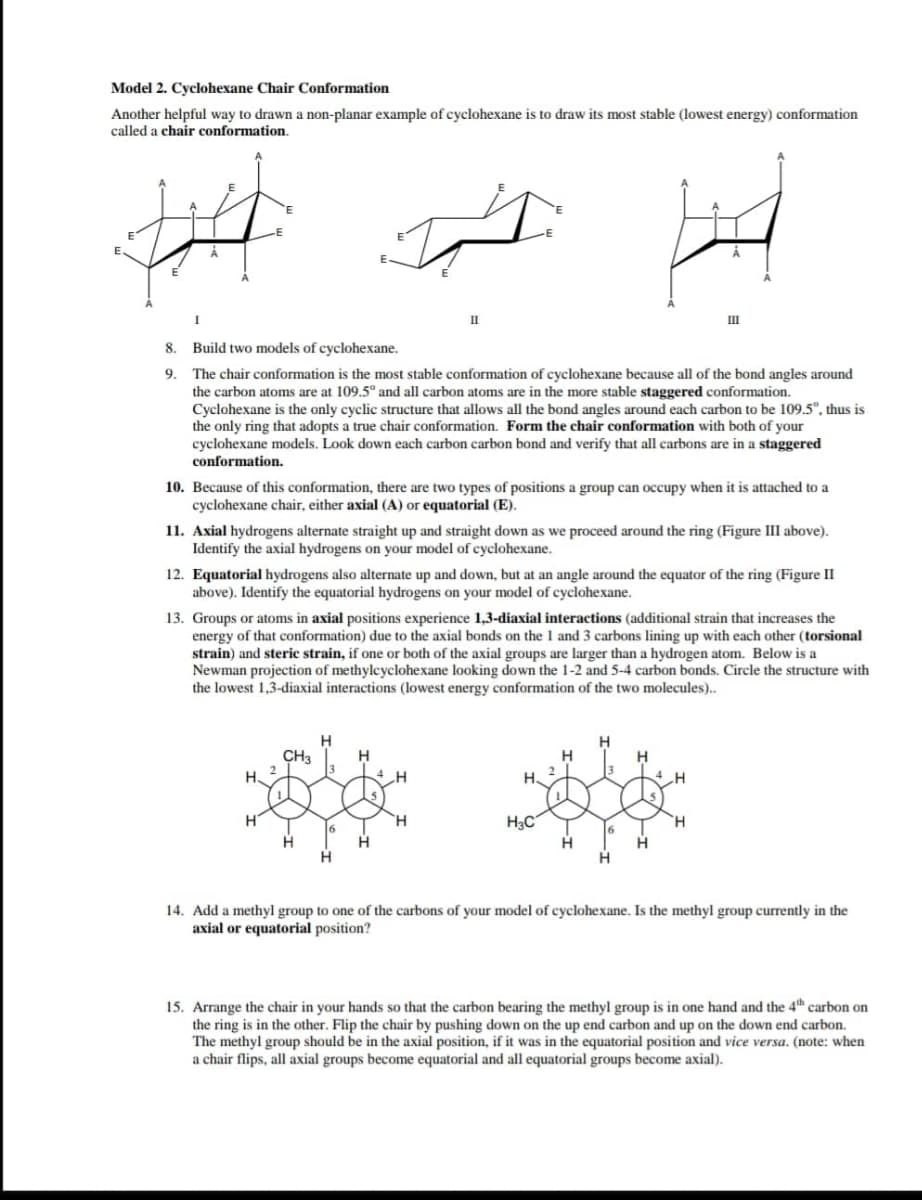Organic Chemistry
8th Edition
ISBN:9781305580350
Author:William H. Brown, Brent L. Iverson, Eric Anslyn, Christopher S. Foote
Publisher:William H. Brown, Brent L. Iverson, Eric Anslyn, Christopher S. Foote
Chapter2: Alkanes And Cycloalkanes
Section2.5: Conformations Of Alkanes And Cycloalkanes
Problem 2.9P: Following is a chair conformation of cyclohexane with the carbon atoms numbered 1 through 6. (a)...
Related questions
Question

Transcribed Image Text:Model 2. Cyclohexane Chair Conformation
Another helpful way to drawn a non-planar example of cyclohexane is to draw its most stable (lowest energy) conformation
called a chair conformation.
III
8.
Build two models of cyclohexane.
The chair conformation is the most stable conformation of cyclohexane because all of the bond angles around
the carbon atoms are at 109.5ª and all carbon atoms are in the more stable staggered conformation.
Cyclohexane is the only cyclic structure that allows all the bond angles around each carbon to be 109.5", thus is
the only ring that adopts a true chair conformation. Form the chair conformation with both of your
cyclohexane models. Look down each carbon carbon bond and verify that all carbons are in a staggered
conformation.
9.
10. Because of this conformation, there are two types of positions a group can occupy when it is attached to a
cyclohexane chair, either axial (A) or equatorial (E).
11. Axial hydrogens alternate straight up and straight down as we proceed around the ring (Figure III above).
Identify the axial hydrogens on your model of cyclohexane.
12. Equatorial hydrogens also alternate up and down, but at an angle around the equator of the ring (Figure I
above). Identify the equatorial hydrogens on your model of cyclohexane.
13. Groups or atoms in axial positions experience 1,3-diaxial interactions (additional strain that increases the
energy of that conformation) due to the axial bonds on the 1 and 3 carbons lining up with each other (torsional
strain) and steric strain, if one or both of the axial groups are larger than a hydrogen atom. Below is a
Newman projection of methylcyclohexane looking down the 1-2 and 5-4 carbon bonds. Circle the structure with
the lowest 1,3-diaxial interactions (lowest energy conformation of the two molecules).
CH3
H
H
H
H.
H.
H3C
H.
14. Add a methyl group to one of the carbons of your model of cyclohexane. Is the methyl group currently in the
axial or equatorial position?
15. Arrange the chair in your hands so that the carbon bearing the methyl group is in one hand and the 4th carbon on
the ring is in the other. Flip the chair by pushing down on the up end carbon and up on the down end carbon.
The methyl group should be in the axial position, if it was in the equatorial position and vice versa. (note: when
a chair flips, all axial groups become equatorial and all equatorial groups become axial).
Expert Solution
This question has been solved!
Explore an expertly crafted, step-by-step solution for a thorough understanding of key concepts.
This is a popular solution!
Trending now
This is a popular solution!
Step by step
Solved in 3 steps with 2 images

Knowledge Booster
Learn more about
Need a deep-dive on the concept behind this application? Look no further. Learn more about this topic, chemistry and related others by exploring similar questions and additional content below.Recommended textbooks for you

Organic Chemistry
Chemistry
ISBN:
9781305580350
Author:
William H. Brown, Brent L. Iverson, Eric Anslyn, Christopher S. Foote
Publisher:
Cengage Learning

Organic Chemistry: A Guided Inquiry
Chemistry
ISBN:
9780618974122
Author:
Andrei Straumanis
Publisher:
Cengage Learning

Organic Chemistry
Chemistry
ISBN:
9781305580350
Author:
William H. Brown, Brent L. Iverson, Eric Anslyn, Christopher S. Foote
Publisher:
Cengage Learning

Organic Chemistry: A Guided Inquiry
Chemistry
ISBN:
9780618974122
Author:
Andrei Straumanis
Publisher:
Cengage Learning